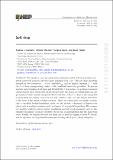Soft drop
Author(s)
Marzani, Simone; Soyez, Gregory; Thaler, Jesse; Larkoski, Andrew
DownloadLarkoski-2014-Soft drop.pdf (916.1Kb)
PUBLISHER_CC
Publisher with Creative Commons License
Creative Commons Attribution
Terms of use
Metadata
Show full item recordAbstract
We introduce a new jet substructure technique called “soft drop declustering”, which recursively removes soft wide-angle radiation from a jet. The soft drop algorithm depends on two parameters — a soft threshold z [subscript cut] and an angular exponent β — with the β = 0 limit corresponding roughly to the (modified) mass drop procedure. To gain an analytic understanding of soft drop and highlight the β dependence, we perform resummed calculations for three observables on soft-dropped jets: the energy correlation functions, the groomed jet radius, and the energy loss due to soft drop. The β = 0 limit of the energy loss is particularly interesting, since it is not only “Sudakov safe” but also largely insensitive to the value of the strong coupling constant. While our calculations are strictly accurate only to modified leading-logarithmic order, we also include a discussion of higher-order effects such as multiple emissions and (the absence of) non-global logarithms. We compare our analytic results to parton shower simulations and find good agreement, and we also estimate the impact of non-perturbative effects such as hadronization and the underlying event. Finally, we demonstrate how soft drop can be used for tagging boosted W bosons, and we speculate on the potential advantages of using soft drop for pileup mitigation.
Date issued
2014-05Department
Massachusetts Institute of Technology. Center for Theoretical Physics; Massachusetts Institute of Technology. Department of Physics; Massachusetts Institute of Technology. Laboratory for Nuclear ScienceJournal
Journal of High Energy Physics
Publisher
Springer-Verlag
Citation
Larkoski, Andrew J., Simone Marzani, Gregory Soyez, and Jesse Thaler. “Soft Drop.” J. High Energ. Phys. 2014, no. 5 (May 2014).
Version: Final published version
ISSN
1029-8479
1126-6708